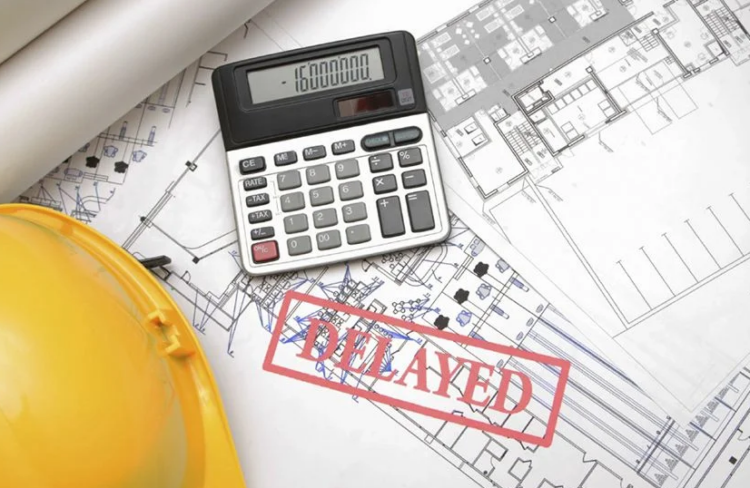Several factors can cause construction delays—including labor shortages. According to McKinsey, more than 400,000 construction positions remained unfilled by October of last year.
But it’s not only labor shortages that contribute to construction projects falling behind months, and even years. Here are some other factors that can cause setbacks and postponed projects, grouped into types, and what you can do to recover.
Page Contents
Types of construction schedule delays
Excusable schedule delays

An excusable delay is a type of delay caused by factors that contractors cannot control. And since contractors can’t control these factors, they can’t be deemed negligent and held responsibly. Examples of excusable delays include:
- Natural disasters, fire, and floods
- Approval of delay by the national government
- Plan changes initiated by the developer
- Interference by government agencies
Non-excusable delays
A non-excusable delay is a delay caused by factors that contractors can control. Non-excusable delays hold the contractor responsible and can result in penalization. For this reason, it’s recommended that developers have a clear contract and clarify any potential issues that may arise with their contractors. Examples of non-excusable delays are:
- Delays caused by poor workmanship
- Delays caused by the late performance of subcontractors
- Late performance due to failure to order materials on time
- Labor strikes are caused by the unwillingness of a contractor to negotiate
Compensable delays
A compensable delay is a type of delay that involves compensation. This type of delay ensures that either the contractor or property owner is compensated due to the fault of the other party.
Concurrent delays

img source: singleton.com
Construction projects often involve several moving parts that must work together for the project’s success. A concurrent delay results from one or two moving parts failing to work harmoniously to achieve a specific target.
The problem with this type of delay is that it’s difficult to identify the level at which one party is liable. Project delays must be immediately resolved, with a corrective schedule created for the project to get back on track.
Recovering a stalled project
When your construction project stalls, recovery can be a difficult, costly, and time-consuming process. Construction optioneering platforms like ALICE have made the process much easier, using algorithms to identify the best possible recovery plan.
Once a contractor inputs all the necessary data, the platform determines the best alternative and strategy for quick recovery.
How to generate corrective schedules

img source: mpsoftware.com
1. Get the right tools for the job
If you’re going to generate corrective schedules for your construction project, you’ll need to have the right software. Creating a corrective schedule can be a daunting task. You’ll need to have a full audit done to identify what resources are currently available and how they can be utilized to get your project back on track.
While you can do this using an Excel spreadsheet, it can take quite a lot of time and creates room for error. Instead, consider using optioneering platforms created for project recovery. The platform should have an auto-grouping functionality and determine the chronological order in which a task should be completed.
2. Identify potential challenges
Once you have the right tools for the job, you’ll need to identify potential challenges that may affect your recovery plan. After all, construction delays can be caused by several factors, including (but not limited to) financial constraints, labor and equipment shortages, and unforeseen circumstances like adverse weather conditions.
Once you’ve identified these challenges, you’ll need to rank them in order of priority. For example, if you have financial and labor shortages, you’ll need to know which ones to resolve first. Practically, you’d need to address the financial problem first since lacking money can prevent you from paying for labor.
If you’re expecting to finance from a property investor or a bank, you’ll need to work with the bank to find out when they’ll disperse the money.
3. Add duration

img source: levelset.com
After you’ve identified and ranked priority tasks, you’ll need to add a start and finish date to them. At this stage, you’ll be creating a corrective construction schedule. A construction schedule is a timeline of when a specific task will be completed.
One important thing you’ll need to ensure is that the timeframe is realistic. When adding time to your tasks, factor in externalities such as national holidays, weather forecasts, and vacation days. Other factors you’ll also need to consider are the time it takes for material and equipment delivery, as well as non-task-related scheduling activities.
4. Allocate resources
A corrective construction schedule has two main parts: activities and resources. Each activity requires several construction resources, such as material, labor, and equipment. If a particular task is allocated to a particular team, it can become confusing to keep track of them and even hold them accountable.
Therefore, if you’re doing it manually, it’s advisable to color-code tasks. Of course, this will not be an issue if you use a construction optioneering platform.
You’ll also need to ensure that construction resources (labor, equipment, and material) are not overstretched or overburdened. If you over-stretch labor and give them too many tasks, it can demoralize them and cause burnout, resulting in more delays.
5. Execute and delay
Once you’ve allocated your resources, it’s time to execute them to recover your construction project. To ensure you don’t find yourself experiencing the same problems, you should seek to resolve and eliminate every construction risk before it causes further delay.
Using modern optioneering platforms makes it easier to identify overstretched resources. Additionally, you’ll be able to identify teams that are behind schedule and take correct measures before your recovery plan is in the red.





